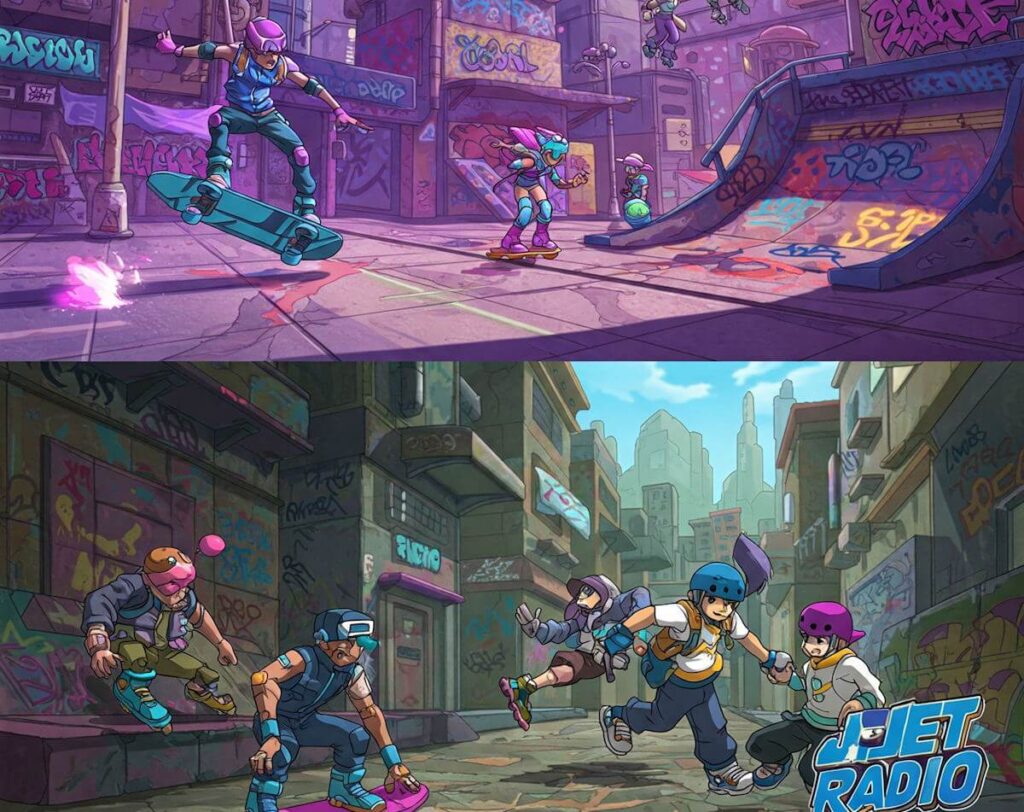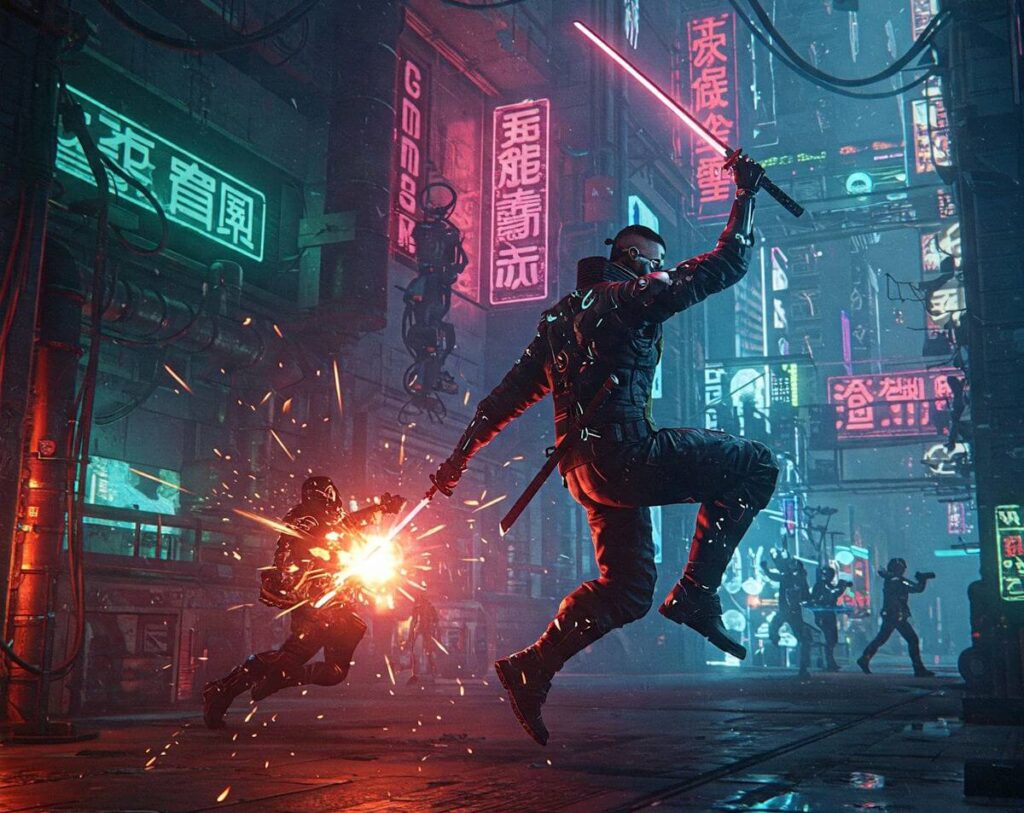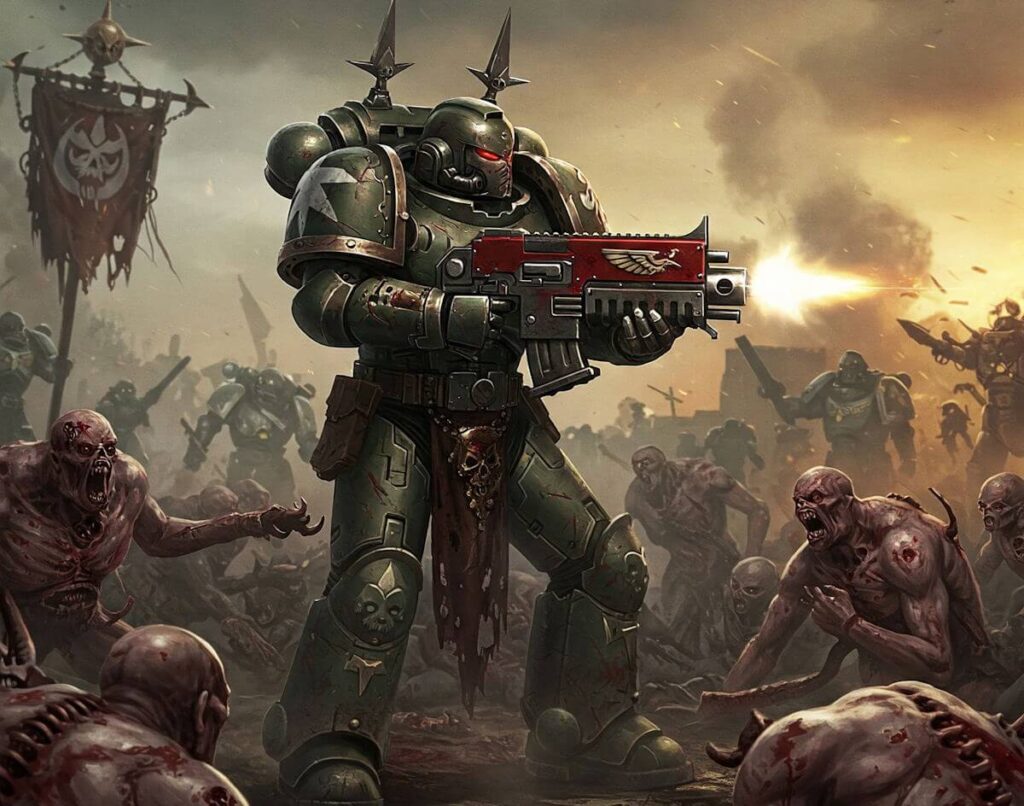Jet Set Radio, released by Sega in 2000, is often celebrated as a pioneering title in the action-adventure genre, revered for its distinctive aesthetic and innovative gameplay mechanics. Set in a vibrant, futuristic Tokyo, players take on the role of a gang of inline skaters who are on a mission to protect their turf from rival gangs and oppressive authorities. The game is characterized by its unique cel-shaded graphics, which give it an animated feel, alongside an eclectic soundtrack that features a variety of music genres, enhancing its urban cultural setting. Players traverse the city, performing tricks and tagging graffiti while evading police, ultimately creating an immersive experience that captivates players through its stylistic charm and engaging gameplay.
On the other hand, Bomb Rush Cyberfunk serves as an indie homage to Jet Set Radio, capturing the essence and spirit of the original while introducing new elements. Developed by Team Reptile, this game draws heavily from its predecessor’s aesthetic and gameplay dynamics but aims to expand on them with modern mechanics and enhanced graphics. Set in an open-world environment, Bomb Rush Cyberfunk embraces a similar theme of street culture, combining skateboarding, graffiti artistry, and fast-paced action. With its carefully crafted world, players are invited to explore and express their creativity through kinetic movement and artistic tagging that pays tribute to the urban landscape.
Both titles embrace a vibrant artistic direction and maintain an emphasis on urban exploration, yet they approach gameplay and thematic elements from slightly different perspectives. Jet Set Radio established a rich blueprint in early 2000s gaming, while Bomb Rush Cyberfunk revitalizes those themes for a new generation. As we delve deeper into their gameplay mechanics, storylines, and artistic influences, a comprehensive comparison of these two noteworthy games will illuminate their unique contributions to the gaming landscape.
Gameplay Mechanics: A Closer Look
The core gameplay mechanics of both Bomb Rush Cyberfunk and Jet Set Radio offer a captivating experience for players, underpinned by similar themes of movement, style, and urban exploration. At the heart of these games is the innovative skate-and-tag mechanic, a defining element that encourages fluid motion and creativity on urban landscapes. In Jet Set Radio, players utilize rollerblades to traverse through sprawling cityscapes while performing tricks and tagging graffiti, establishing a playful yet competitive atmosphere. This foundational gameplay has greatly influenced Bomb Rush Cyberfunk, which embraces the essence of movement while introducing its unique elements.
While Jet Set Radio emphasized an artistic approach to tagging, Bomb Rush Cyberfunk expands on this concept by incorporating new movement systems that heighten the sense of speed and agility. In Bomb Rush Cyberfunk, the mechanics allow for a more expansive range of movements, including wall-running, grinding, and performing aerial tricks. These enhancements not only improve the player’s ability to navigate the environment but also add layers of depth to the gameplay, encouraging players to master intricate combos in a more dynamic urban setting.
Additionally, Bomb Rush Cyberfunk introduces combat elements, which were less pronounced in Jet Set Radio. While players in both games contend with rival gangs, Bomb Rush Cyberfunk allows players to engage in powers-based confrontations, utilizing special abilities characterized by each character. This innovation creates a more varied gameplay experience and integrates a tactical layer, as players must strategize their approach to both tagging and combat. Ultimately, while the foundational gameplay mechanics remain rooted in the skate-and-tag philosophy of Jet Set Radio, Bomb Rush Cyberfunk represents an evolution of these concepts, with innovations that embrace modern gaming sensibilities, making it an engaging experience for both new and veteran players alike.
Art Style and Aesthetics
The visual style of a video game often plays a crucial role in defining its atmosphere and overall appeal. In the case of Jet Set Radio, the game utilizes cel-shaded graphics to create a vibrant and dynamic world. This technique allows for bold colors and smooth animations, which contribute significantly to the game’s unique charm. The cel-shading aesthetic not only enhances character designs, making them vivid and memorable, but also complements the game’s energetic soundtrack and gameplay. The result is a visual experience that effectively captures the essence of urban culture and skateboarding, immersing players in a world that feels alive and bustling.
On the other hand, Bomb Rush Cyberfunk employs a distinct artistic vision that pays homage to its predecessor while carving out its identity. The game incorporates a more varied color palette with a mix of both vibrant and subtle tones, creating a visual experience that is rich and engaging. Character designs in Bomb Rush Cyberfunk are notable for their diverse and eclectic styles, reflecting the individuality of each character, which is fundamental to the gameplay experience. Shades of neon and earthy tones blend to form environments that evoke a sense of nostalgia while simultaneously feeling fresh and innovative.
Both games exhibit a remarkable level of creativity in their art styles, helping convey their respective themes effectively. Jet Set Radio’s cel-shaded graphics maintain a stylized charm that appeals to players looking for a unique visual representation of skate culture. Meanwhile, Bomb Rush Cyberfunk’s artistic choices celebrate this legacy while fostering its own distinct aesthetic, ensuring players experience novelty and familiarity in equal measures. By marrying style with substance, both titles invite players into their worlds, showcasing how art direction can enhance gameplay and player engagement.
Soundtrack and Audio Experience
The audio experience plays a pivotal role in enhancing the overall gameplay of both Bomb Rush Cyberfunk and Jet Set Radio. Starting with Jet Set Radio, this title is renowned for its eclectic soundtrack that harmoniously blends J-pop, hip-hop, and electronic music. Each track complements the dynamic environments and fast-paced gameplay, serving to immerse players in a vibrant urban landscape. The music not only accentuates the thrill of skating through the streets but also enhances the narrative, establishing an unmistakable mood that resonates well with the game’s youthful and rebellious theme. Iconic tracks from artists like Hideki Naganuma have contributed significantly to the game’s legacy, making the soundtrack a nostalgic cornerstone for many gamers.
In contrast, Bomb Rush Cyberfunk approaches its soundtrack with a fresh and modern perspective while staying true to its genre roots. Drawing inspiration from Jet Set Radio, this title features an energetic mix of funk, hip-hop, and electronic beats designed to elevate the gameplay experience. The developers have curated a diverse lineup of tracks that keep players engaged and motivated as they navigate through its vibrant, graffiti-filled world. With contributions from various artists, the game’s soundtrack encapsulates a sense of creative freedom, appealing to players who appreciate dynamic audio experiences. Moreover, the carefully selected sound effects and ambient audio elements further enrich the overall atmosphere, making each grind and trick feel more impactful.
When comparing the two, it is evident that both soundtracks serve distinct purposes within their respective games. While Jet Set Radio leans heavily on its iconic tracks to create a nostalgic experience, Bomb Rush Cyberfunk opts for a fresh, modern sound that paves the way for its unique gameplay mechanics. The effectiveness of these soundtracks lies in their ability to enhance immersion and emotional engagement as players traverse through their respective realities. Ultimately, both games demonstrate the importance of an engaging audio experience in delivering enjoyment and excitement.
Narrative and Characters
The essence of any gaming experience often lies in its narrative and character development, and both Bomb Rush Cyberfunk and Jet Set Radio excel in their storytelling. Jet Set Radio, originally released in 2000, encapsulates a vibrant narrative centered around rebellion against authoritarian control in a stylized urban setting. The game follows a group of skaters known as the GGs, who use graffiti and their skating skills to challenge oppressive forces. This storyline serves as a backdrop to explore themes of freedom, youth culture, and the importance of self-expression. The distinct character designs, each with their own unique abilities and backstories, contribute significantly to the immersion of the player in this rebellious world. Characters like Beat, a skilled inline skater, and Gum, a dynamic and fierce graffiti artist, provide depth through their personal motivations and interactions, enhancing the game’s overall plot.
In contrast, Bomb Rush Cyberfunk, a homage to the genre established by Jet Set Radio, presents a contemporary narrative rich with modern cultural references. The game’s storyline revolves around characters who navigate a neon-lit cityscape, using their skating expertise and graffiti artistry to reclaim their identity amidst a backdrop of digital culture and social commentary. This narrative reflects current societal issues such as the impact of technology on community and individuality. The characters in Bomb Rush Cyberfunk are designed with a flair that mirrors today’s urban aesthetics, incorporating diverse backgrounds and goals that resonate with players. As they traverse this dystopian world, the quests they embark on and the relationships they form emphasize themes of camaraderie and personal growth.
In conclusion, while both games present engaging narratives tied to urban culture, they do so through different lenses. Jet Set Radio taps into the spirit of early 2000s rebellion, while Bomb Rush Cyberfunk resonates with contemporary themes, propelling the genre into the modern age. Together, they showcase the evolution of gaming narratives and character complexities that continue to inspire players worldwide.
Community and Reception
The communities surrounding both Jet Set Radio and Bomb Rush Cyberfunk showcase distinct yet interconnected experiences in the realm of gaming culture. Since its original release in 2000, Jet Set Radio has cultivated a passionate fanbase that celebrates its unique style, vibrant visuals, and innovative gameplay. This legacy is reflected in the multitude of fan-generated content, including art, music remixes, and cosplay, which continues to enrich the gaming landscape. Furthermore, the title has inspired speedrunners who have optimized their playthroughs to achieve record-breaking times, showcasing the game’s deep mechanics and nuances.
Modding communities have also played a vital role in extending the life of Jet Set Radio. The ability for fans to create and share mods has led to new levels, characters, and gameplay tweaks that enhance the original experience. As a result, the title has not only maintained relevance but has also continued to influence new generations of game designers and artists.
Player feedback indicates a growing appreciation for both campaigns and mechanics, as users engage with the title in various ways, such as streaming gameplay and sharing their experiences online. The enthusiasm from the gaming community signifies Bomb Rush Cyberfunk’s potential to carve its own niche, building upon the momentum generated by Jet Set Radio’s enduring legacy.
Technological Innovations and Developments
The advancement of technology in the gaming industry has led to significant changes in gameplay design, graphics, and overall user experience. Bomb Rush Cyberfunk, released in the 2020s, is developed for modern hardware, allowing it to take advantage of enhanced graphical capabilities and processing power compared to its predecessor, Jet Set Radio, which premiered on the Sega Dreamcast in 2000. When analyzing the two games, it is essential to highlight how these technological advancements impact gameplay, engagement, and immersion.
One noticeable difference is the graphical fidelity that modern consoles can achieve, which Bomb Rush Cyberfunk harnesses to create vibrant, detailed environments. The game employs advanced rendering techniques and shader technology that were unavailable during the Jet Set Radio era. This results in a richly colorful aesthetic, making the gameplay more stimulating and visually appealing. Additionally, Bomb Rush Cyberfunk features dynamic lighting and particle effects that enhance realism and immersion, providing players with a more engaging experience.
In terms of gameplay mechanics, Bomb Rush Cyberfunk introduces innovative features that utilize the capabilities of current-generation hardware. This includes enhanced physics engines that allow for more fluid movement and skateboarding mechanics, making the act of traversing the environment feel more natural. Furthermore, the integration of advanced AI for non-playable characters enriches player interaction and immersion, creating a more dynamic world that responds to players’ choices and actions.
In contrast, Jet Set Radio, while groundbreaking for its time, has limitations in terms of its gameplay features due to the technological constraints of its hardware. The simplistic AI and less complex environmental interactions reflect the restrictions of early 2000s technology. Consequently, Bomb Rush Cyberfunk represents a significant evolution in gameplay experience through its innovative use of modern hardware, setting a new standard for future games in this genre.
Cultural Impact and Legacy
The cultural significance of video games often extends beyond their gameplay mechanics, influencing art, fashion, and music. At the forefront of this cultural revolution is Jet Set Radio, a title that not only captivated players upon its release in 2000 but also played a pivotal role in shaping the landscape of action-adventure gaming. Renowned for its striking cel-shaded graphics and vibrant representation of urban youth culture, Jet Set Radio has inspired an entire generation of game developers and artists. The game’s pioneering use of graffiti as a form of expression stood out, reflecting socio-political realities of the time while promoting a sense of community and rebellion through its engaging narrative and gameplay.
Over two decades, its influence can be observed in various forms of media, including fashion trends that echo the game’s colorful aesthetic and music that emulates its distinctive soundtrack, blending genres that resonate with the youth. This legacy is evident in the works of contemporary artists and game designers who draw inspiration from the title, a testament to its enduring impact on popular culture.
In contrast, Bomb Rush Cyberfunk emerges as a modern homage to the beloved classic, capturing the essence of Jet Set Radio while implementing fresh gameplay elements and aesthetics tailored for today’s audience. The game’s creators have encapsulated the spirit of the original, integrating elements like graffiti and urban exploration while pushing boundaries with advanced technology. Although it has yet to establish its legacy fully, Bomb Rush Cyberfunk has the potential to resonate with a new generation, bridging the gap between nostalgia and contemporary gaming culture.
The lasting impression of both games highlights their individual contributions to video game history. Jet Set Radio serves as a cornerstone in understanding gaming’s cultural dynamics, while Bomb Rush Cyberfunk is poised to carve its niche, reflecting the evolution of ideas through creative expression in gaming. As these titles influence future generations, their respective legacies will continue to shape cultural narratives within and beyond the gaming sphere.
Conclusion: Which Game Thrives in Today’s Gaming Landscape?
In examining the dynamics between Bomb Rush Cyberfunk and Jet Set Radio, it becomes evident that both titles occupy a significant space in the gaming culture, albeit through different lenses. Jet Set Radio, a pioneering title from the early 2000s, has built a legacy characterized by its unique art style, memorable soundtrack, and a strong sense of nostalgia among its player base. Its innovative approach to gameplay and community interaction during its release set a benchmark for action-adventure games focused on urban sports.
Conversely, Bomb Rush Cyberfunk seeks to revive and innovate those foundational elements. Drawing inspiration from its predecessor, the game introduces modern mechanics, enhanced visuals, and a new narrative that resonates with both old fans and a younger audience. The combination of contemporary design sensibilities with a homage to the classic makes Bomb Rush Cyberfunk a compelling addition to the genre. Furthermore, the game has an added advantage of benefiting from advances in technology, allowing for more engaging gameplay experiences and immersive worlds.
Community influence also plays a pivotal role in determining which game thrives today. While Jet Set Radio has a dedicated following that cherishes its original content, Bomb Rush Cyberfunk‘s marketing strategy appears tailored to integrate community feedback fostered through social media channels. This adaptive approach allows it to position itself as both a sequel and a fresh endeavor.
When weighing nostalgia against innovation, it is clear that Bomb Rush Cyberfunk has managed to capture the essence of what made Jet Set Radio a classic while also carving out its own identity in a landscape that demands freshness. Therefore, while Jet Set Radio remains an iconic reference point, Bomb Rush Cyberfunk holds the potential to redefine the genre for a new generation of gamers, making it a worthy contender in today’s expansive gaming sphere.




